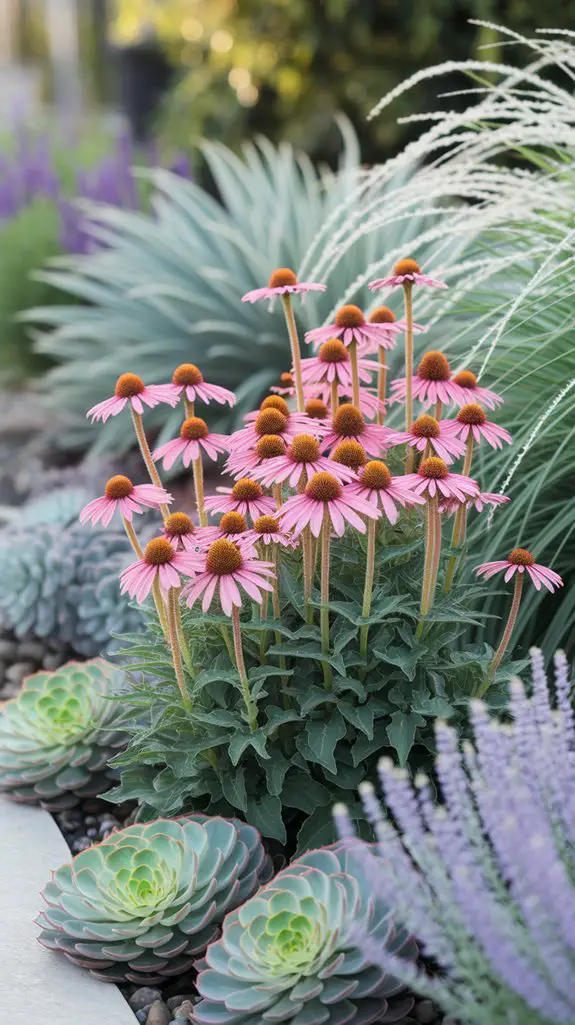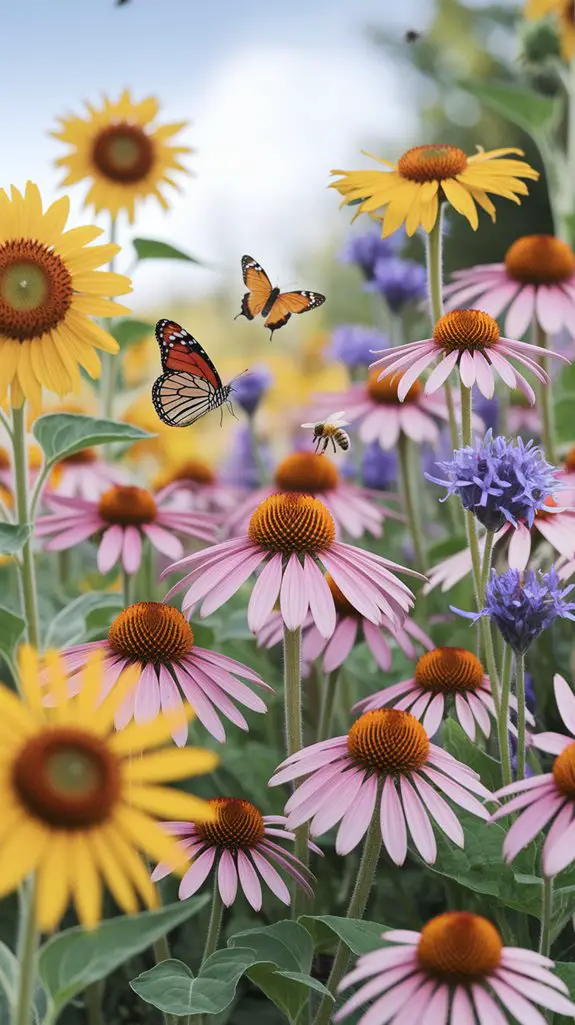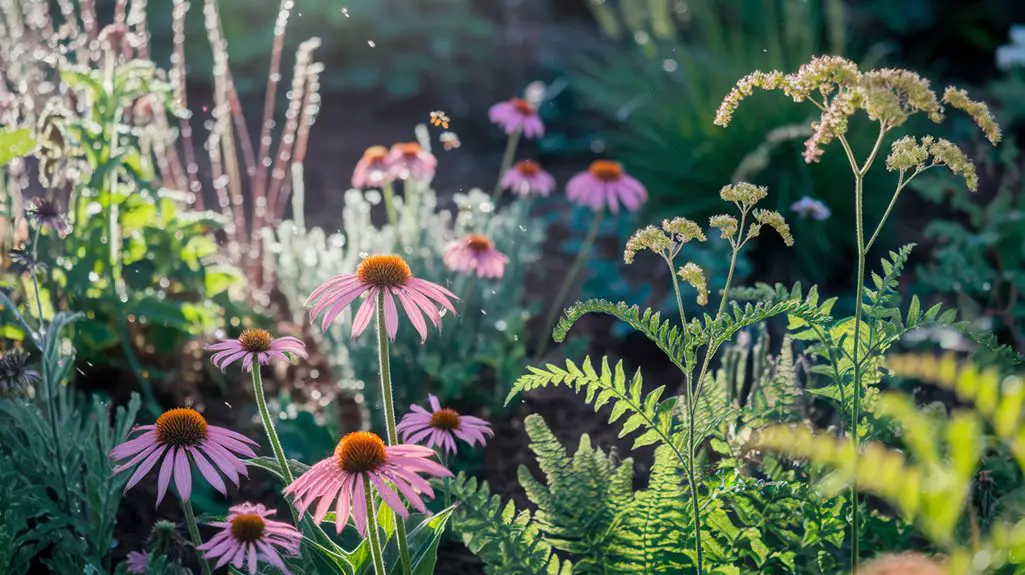You'll find native plants are the cornerstone of any truly eco-friendly garden. They've adapted to local conditions over thousands of years, requiring far less water, fertilizer, and maintenance than exotic species. Consider Echinacea purpurea with its stunning purple blooms or Asclepias tuberosa, a monarch butterfly magnet. Beyond their beauty, these plants strengthen your soil structure and support local wildlife populations. What specific native species might transform your particular landscape?
Why Native Plants Are Essential for Sustainable Landscapes
When you cultivate native plants in your garden, you're implementing a critical ecological strategy that extends far beyond mere aesthetic choices.
Native flora has co-evolved with local soil microbiota, pollinators, and wildlife over millennia, creating intricate ecological networks that non-native species can't replicate.
These indigenous species require considerably less irrigation (40-60% less water than exotics), minimal fertilization, and no pesticide applications.
They've developed natural defense mechanisms against regional pests and diseases, maximizing survival rates while minimizing maintenance requirements.
Additionally, native plants sequester carbon more efficiently in local soil conditions, enhancing your garden's climate mitigation potential.
Water-Conserving Native Perennials for Your Region

Water conservation stands at the forefront of sustainable gardening practices, and selecting appropriate native perennials represents one of the most effective strategies for achieving this goal.
Native perennials have evolved physiological adaptations to thrive in your local precipitation patterns without supplemental irrigation once established.
To maximize water efficiency in your garden, consider these regionally-adapted species:
- Asclepias tuberosa (Butterfly Weed) – Features deep taproots accessing subsoil moisture and waxy leaves reducing transpiration rates.
- Echinacea purpurea (Purple Coneflower) – Employs drought-avoidance through summer dormancy while maintaining robust root systems.
- Baptisia australis (Blue False Indigo) – Utilizes nitrogen-fixing nodules to enhance drought tolerance while minimizing resource requirements.
You'll find these xerophytic species require minimal maintenance while supporting local pollinators and conserving precious water resources. Additionally, incorporating sustainable gardening practices into your routine can further enhance the benefits of your native plant selections.
Pollinator-Friendly Native Flowers That Attract Bees and Butterflies

As pollinators continue to face population declines worldwide due to habitat loss and pesticide use, incorporating native flowering plants into your garden creates essential ecological refuges while enhancing biodiversity. Select species with staggered blooming periods to provide nectar and pollen resources throughout growing seasons. Additionally, using native plants in your garden can significantly improve the chances of attracting and sustaining local wildlife populations.
| Species | Pollinators Attracted | Bloom Period |
|---|---|---|
| *Echinacea purpurea* (Purple Coneflower) | Bees, butterflies, beetles | Mid-summer to fall |
| *Asclepias tuberosa* (Butterfly Weed) | Monarch butterflies, bumblebees | Early to mid-summer |
| *Monarda fistulosa* (Wild Bergamot) | Hummingbirds, bees, clearwing moths | Summer |
You'll achieve maximum ecological benefit by clustering identical species together rather than dispersing them. This planting strategy creates visible "pollinator targets" that facilitate efficient foraging behavior and increases successful reproduction rates among your garden's flowering plants.
Native Ground Covers for Natural Weed Suppression
Beyond pollinator support, native gardens must also address the persistent challenge of weed management.
Native ground covers offer an ecological solution by creating dense vegetative matrices that naturally suppress unwanted plant species while enhancing soil health. Additionally, utilizing native plant landscaping not only helps with weed control but also promotes local biodiversity.
Three exceptional native ground covers for weed suppression include:
- *Fragaria virginiana* (Wild Strawberry) – Forms extensive stoloniferous networks with 3-10cm height, thrives in zones 3-8, and offers edible berries while preventing soil erosion.
- Asarum canadense(Wild Ginger) – Creates 10-15cm thick coverage in partial shade, features distinctive kidney-shaped foliage, and releases allelopathic compounds inhibiting weed germination.
- Waldsteinia fragarioides(Barren Strawberry) – Maintains year-round semi-evergreen foliage, spreads 30-60cm annually, tolerates dry conditions, and establishes complete ground coverage within 2-3 growing seasons.
Drought-Resistant Native Plants for Low-Maintenance Gardens
While increasing climate uncertainty drives gardening trends toward resource conservation, drought-resistant native plants have emerged as essential components for sustainable landscape design.
These xerophytes have evolved specialized adaptations—waxy cuticles, reduced leaf surface area, and deep root systems—to thrive with minimal irrigation.
Consider incorporating Asclepias tuberosa (butterfly weed), which supports monarch populations while tolerating poor soils and drought conditions.
Echinacea purpurea offers both medicinal properties and drought tolerance after establishment. For structural elements, Schizachyrium scoparium (little bluestem) provides year-round interest with minimal water requirements.
You'll find that these natives require approximately 70% less water than conventional ornamentals while simultaneously enhancing biodiversity.
Their extensive root structures improve soil structure and water infiltration rates, further reducing irrigation needs in your garden ecosystem. Additionally, pest-resistant gardens can be achieved by strategically selecting native plants that deter unwanted insects naturally.
Native Shrubs and Trees for Wildlife Habitat Creation
Native shrubs and trees form the structural backbone of wildlife-supporting landscapes, providing essential nesting sites, food resources, and protective cover unavailable in conventional ornamental gardens.
You'll attract diverse fauna by selecting species with complementary ecological functions.
Consider these habitat-enhancing woody plants:
- *Quercus* species (oaks) – Support over 500 Lepidoptera species while producing nutritionally-dense acorns for mammals and birds.
- Vaccinium corymbosum(highbush blueberry) – Provides spring nectar for pollinators, summer fruit for over 40 bird species, and vibrant autumn foliage.
- Cornus florida(flowering dogwood) – Offers high-fat berries vital for migratory birds, early-season pollen, and exfoliating bark that harbors beneficial insects.
Plant in multi-layered configurations mimicking natural forest structure to maximize biodiversity potential while creating visual interest throughout your landscape.
Edible Native Plants for Food Production and Sustainability
Incorporating edible native plants into your garden creates a multifunctional landscape that serves both ecological and practical human needs. By cultivating indigenous food species, you'll establish sustainable harvest cycles while supporting local biodiversity. Additionally, including pollinator-friendly herbs in your garden can enhance the overall health of the ecosystem while attracting beneficial insects.
| Species | Characteristics |
|---|---|
| *Amelanchier alnifolia* (Serviceberry) | Antioxidant-rich berries; drought-tolerant; zones 2-9 |
| *Vaccinium corymbosum* (Highbush Blueberry) | Acidic soil preference; spring flowers; fall foliage |
| *Fragaria virginiana* (Wild Strawberry) | Groundcover habit; nitrogen-responsive; self-propagating |
| *Asimina triloba* (Pawpaw) | Custard-like fruit; tropical flavor profile; understory tree |
Select species appropriate for your bioregion's soil conditions and climate patterns. You'll find native edibles typically require less irrigation, fertilization, and pest management than non-native cultivars, resulting in reduced resource inputs while yielding nutritionally dense harvests.
Seasonal Native Plant Combinations for Year-Round Interest
Designing a garden that maintains visual interest throughout all seasons requires strategic selection of native plant species with complementary life cycles and phenological characteristics.
You'll achieve maximum ecological impact by layering plants that sequentially dominate the visual landscape.
- Spring Ephemerals with Summer Bloomers – Pair Mertensia virginica (Virginia bluebells) and Trillium grandiflorum (white trillium) with later-emerging Echinacea purpurea (purple coneflower) and Asclepias tuberosa (butterfly weed).
- Summer-to-Fall Shift – Combine Solidago speciosa (showy goldenrod) with Symphyotrichum novae-angliae (New England aster) for continuous blooms from July through October.
- Winter Structure – Incorporate Panicum virgatum (switchgrass) and Ilex verticillata (winterberry) for architectural interest and essential wildlife food during dormant months.
How to Source and Establish Native Plants in Your Garden
When establishing a successful native plant garden, sourcing high-quality plant material represents the critical first step in your ecological restoration project. Seek specialized native plant nurseries where genetic provenance and local ecotypes are prioritized.
Look for nurseries that practice sustainable propagation methods and avoid wild-harvested specimens.
Before planting, analyze your site's soil profile, hydrology, and microclimates. Match plant selections to these conditions rather than altering the site.
Install plants during dormant seasons—fall for woody species, spring for herbaceous taxa—to minimize transplant shock. Space specimens according to mature dimensions, not current size.
Water deeply but infrequently during the establishment period, which typically spans 1-3 growing seasons.
Avoid high-nitrogen fertilizers that can stimulate excessive foliar growth at the expense of root development.
Conclusion
Your native plant choices can transform your landscape into a resilient ecosystem. Studies indicate that native plant gardens support 3-4 times more beneficial insect biomass than non-native landscapes (Tallamy, 2020). This increased diversity creates cascading ecological benefits throughout the food web. By selecting Echinacea purpurea, Asclepias tuberosa, and other regionally adapted Asteraceae and Fabaceae family members, you'll establish microclimates that reduce water consumption by 60-80% compared to traditional gardens.




